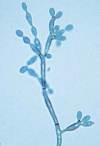Chromoblastomycosis
- PMID: 25395928
- PMCID: PMC4221348
- DOI: 10.5114/pdia.2014.40949
Chromoblastomycosis
Abstract
Chromoblastomycosis is a chronic fungal infection of the skin and subcutaneous tissue. The infection usually results from a traumatic injury and inoculation of microorganism from a specific group of dematiaceous fungi (usually Fonsecaea pedrosoi, Phialophora verrucosa, Cladophialophora carrionii). In the tissues fungi produce characteristic sclerotic cells or muriform cells. Dermal lesions can range from small nodules to large papillary-like eruptions. The disease has been described worldwide but the prevalence is higher in rural populations in countries with a tropical or subtropical climate, such as Madagascar in Africa and Brazil in South America. Diagnostic techniques are based on direct examination, culture and histopathology. Despite a variety of treatment modalities, which include long courses of antifungals, surgical excision and destructive physical therapies, the disease remains one of the most difficult deep mycotic infections to eradicate.
Keywords: Fonsecaea pedrosoi; diagnosis; epidemiology; mycoses; treatment.
Figures




References
-
- Queiroz-Telles F, Esterre P, Perez-Blanco M, et al. Chromoblastomycosis: an overview of clinical manifestations, diagnosis and treatment. Med Mycol. 2009;47:3–15. - PubMed
-
- Ajello L. The gamut of human infections caused by dematiaceous fungi. Jpn J Med Mycol. 1981;22:1–5.
-
- Castro LGM, de Andrade TS. Chromoblastomycosis: still a therapeutic challenge. Expert Review of Dermatology. 2010;5:433–44.
-
- Schwartz R, Baran E. Chromoblastomycosis e-medicine from WebMD. 2010. Available at: http://emedicine.medscape.com/article/1092695-overview.
-
- Odds FC, Arai T, Disalvo AF, et al. Nomenclature of fungal diseases: a report and recommendations from a sub-committee of the international society for human and animal mycology (isham) J Med Vet Mycol. 1992;30:1–10. - PubMed
Publication types
LinkOut - more resources
Full Text Sources
Other Literature Sources
